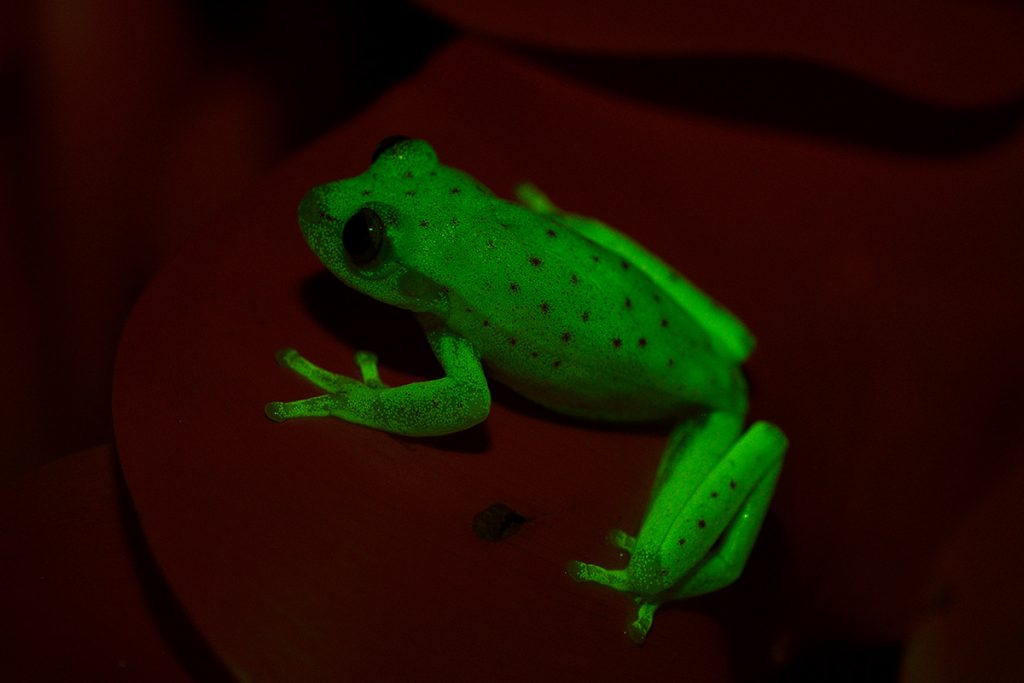Fluorescent tree frog species glows in the dark
By Emma Gruner, Staff Writer
In this era of political ugliness, it is all too easy to become discouraged. As our world appears to crumble with the chaos around us, we find ourselves hoping for something fun, something whimsical, or something no one could be offended by. As it turns out, a team of scientists in Argentina discovered the solution: a glow-in-the-dark frog!
Technically speaking, the term is fluorescent. Fluorescence is defined as the ability to absorb light at short wavelengths (often in the ultraviolet region) and reemit it at longer wavelengths (often in the visible region). This marks an important distinction from bioluminescence, or the ability of an organism to produce its own light from chemical reactions. Fluorescence is fairly common amongst ocean-dwelling creatures like fish, coral, and sharks, but it is a much rarer occurrence among land animals. Until recently, the only known cases were a few species of parrots and scorpions. Earlier this month, however, a group of researchers from the Bernardino Rivadavia Natural Sciences Museum in Buenos Aires decided to study the pigment of the South American polka dot tree frog (Hypsiboas punctatus), using specimens collected near the town of Santa Fe, Argentina. These frogs normally appear a mottled brownish-green, but, as the researchers were amazed to discover, they emit a vivid blue-green glow when exposed to ultraviolet light. Not only does this discovery mark the first instance of fluorescence seen among amphibians, but it also reveals an entirely new chemical method of exhibiting this quality. The research team, which includes specialists from the University of Buenos Aires, the University of São Paulo, and the City University of New York published their findings in Proceedings of the National Academy of Sciences on March 13.
In the initial stages of their research, the team was quick to note the presence of the pigment bilverdin within the frog’s tissues. While appearing green under normal light conditions, Bilverdin has been associated in other species with a mild red fluorescence. But when the researchers exposed the frog to the UVA flashlight, they were met with not a faint red but an intense blue-green. As the team determined later, this color could be attributed to three molecules: hyloin-L1, hyloin-L2, and hyloin-G1. These molecules are found within the frog’s lymph tissue, skin, and glandular secretions. These molecules, which contain a ring structure and a hydrocarbon chain, are “very different from fluorophores found in other vertebrates, which are usually proteins or polyenic chains,” according to Maria Gabriella Lagoria of the University of Buenos Aires . Not only are these new fluorophores chemically unique, but they are also unusually bright, emitting about 18% as much light as a full moon.
In general, fluorescence is still a poorly understood topic within the scientific community. Possible explanations for its purpose include everything from camouflage to communication to mate attraction. In the case of the South American polka dot tree frog, the researchers have even less to go on. Since they currently have no data about the frog’s visual systems or photoreceptors, they do not even know whether the frogs can see each other’s fluorescence. The team plans to conduct further research to answer this very question and also to test whether fluorescence is present in any of the other 250 translucent-skinned tree frog species. The researchers are very excited to continue their studies in this realm, and with any luck, their enthusiasm will spread.
“I’m really hoping that other colleagues will be very interested in this phenomenon, and that they will start carrying a UV flashlight to the field, ” said Julián Faivovich of the University of Buenos Aires.

